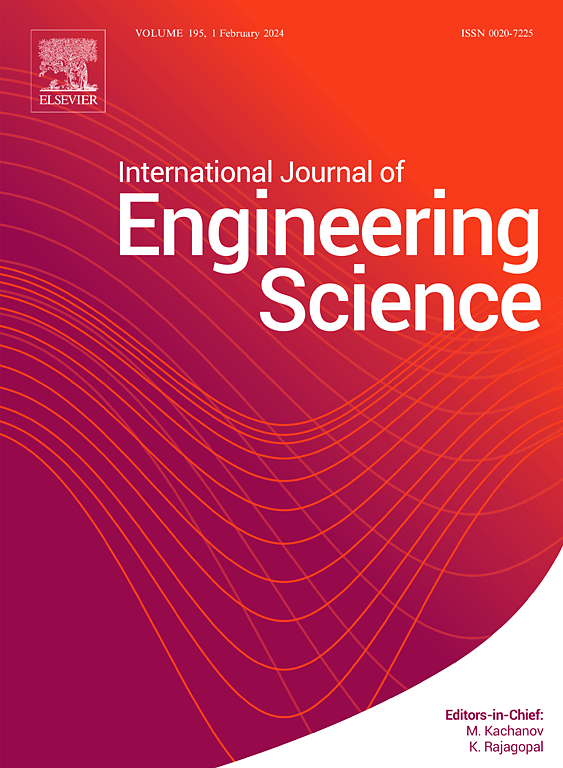周期性三维小尺寸固体波传播分析的新计算框架
IF 5.7
1区 工程技术
Q1 ENGINEERING, MULTIDISCIPLINARY
International Journal of Engineering Science
Pub Date : 2025-07-28
DOI:10.1016/j.ijengsci.2025.104350
引用次数: 0
摘要
分析弹性波在周期性小尺寸结构中的传播在许多微纳米工程器件的设计中起着重要的作用。然而,由于需要特别的尺寸依赖连续体理论来捕捉尺寸效应,因此应开发相关的计算工具来表征波的传播特性。在此背景下,本文介绍了一种原始的计算框架来建立任意形状的周期性三维小尺寸固体的色散图,该色散图由已建立的Eringen非局部积分理论建模。该框架利用一个合适的周期Bloch方差来表示单元格的积分-微分自由振动平衡方程弱表达式中涉及的响应变量。基于Bloch函数的周期性,并引入适当的变量变换,证明了单元格中某一点的响应与固体中所有点的响应耦合的积分可以还原为仅在单元格域上定义的积分之和。这一显著的结果为用单元格自由振动平衡方程的有限元形式来解决波传播问题铺平了道路。单元格的自由振动平衡方程包括标准质量矩阵、局部刚度矩阵和非局部刚度矩阵,后者由非局部矩阵的无限求和来表示,考虑了单元格与固体周围单元之间的非局部相互作用。事实上,根据为非局部积分模型选择的核函数的非局部视界,可以将求和截断到有限阶,并且可以从线性特征值问题中获得色散图,该问题在单元格的有限元自由振动平衡方程中得到Bloch条件。数值应用证实了所提框架的正确性和准确性,这使得Eringen非局部积分理论能够在任意形状的周期性三维小尺寸结构中一致地应用于研究波的传播,这是作者所知的第一次。本文章由计算机程序翻译,如有差异,请以英文原文为准。
A novel computational framework for wave propagation analysis of periodic 3D small-size solids
Analysing elastic wave propagation in periodic small-size structures plays an important role in the design of many micro- and nano-engineering devices. However, as ad hoc size-dependent continuum theories are required to capture size effects, pertinent computational tools shall be developed to characterize the wave propagation properties. In this context, this paper introduces an original computational framework to build the dispersion diagram of periodic 3D small-size solids of arbitrary shape, as modelled by the well-established Eringen’s nonlocal integral theory. The framework makes use of a suitable periodic Bloch ansatz to represent the response variables involved in the weak formulation of the integro-differential free-vibration equilibrium equations of the unit cell. Building on the periodicity of the Bloch ansatz and introducing an appropriate change of variables, it is shown that the integral coupling the response at a given point of the unit cell to the responses at all points of the solid can be reverted to the summation of integrals defined on the domain of the unit cell only. This remarkable result paves the way to solve the wave propagation problem by a finite element formulation of the free-vibration equilibrium equations of the unit cell, which involves a standard mass matrix, a local stiffness matrix and a nonlocal stiffness matrix, with the latter being expressed by the infinite summation of nonlocal matrices accounting for the nonlocal interactions between the unit cell and the surrounding cells of the solid. In fact, the summation can be truncated to a finite order depending on the nonlocal horizon of the kernel function selected for the nonlocal integral model and the dispersion diagram can be obtained from a linear eigenvalue problem, derived enforcing the Bloch conditions in the finite element free-vibration equilibrium equations of the unit cell. Numerical applications substantiate correctness and accuracy of the proposed framework, which enables a consistent application of the Eringen’s nonlocal integral theory to study wave propagation in periodic 3D small-size structures of arbitrary shape, for the first time to the best of authors’ knowledge.
求助全文
通过发布文献求助,成功后即可免费获取论文全文。
去求助
来源期刊

International Journal of Engineering Science
工程技术-工程:综合
CiteScore
11.80
自引率
16.70%
发文量
86
审稿时长
45 days
期刊介绍:
The International Journal of Engineering Science is not limited to a specific aspect of science and engineering but is instead devoted to a wide range of subfields in the engineering sciences. While it encourages a broad spectrum of contribution in the engineering sciences, its core interest lies in issues concerning material modeling and response. Articles of interdisciplinary nature are particularly welcome.
The primary goal of the new editors is to maintain high quality of publications. There will be a commitment to expediting the time taken for the publication of the papers. The articles that are sent for reviews will have names of the authors deleted with a view towards enhancing the objectivity and fairness of the review process.
Articles that are devoted to the purely mathematical aspects without a discussion of the physical implications of the results or the consideration of specific examples are discouraged. Articles concerning material science should not be limited merely to a description and recording of observations but should contain theoretical or quantitative discussion of the results.
 求助内容:
求助内容: 应助结果提醒方式:
应助结果提醒方式:


